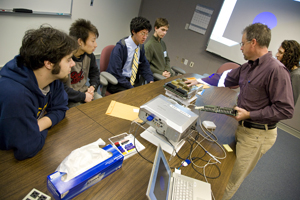NERSC Employees Inspire Future Computer Scientists
 NERSC employees Katie Antypas and David Paul (pictured on the right) introduce four Albany High School students to the intricacies of parallel computing with parts from the center’s decommissioned Seaborg supercomputer at a job shadow tour of the Berkeley Lab’s Oakland Science Facility last Wednesday.
NERSC employees Katie Antypas and David Paul (pictured on the right) introduce four Albany High School students to the intricacies of parallel computing with parts from the center’s decommissioned Seaborg supercomputer at a job shadow tour of the Berkeley Lab’s Oakland Science Facility last Wednesday.
Paul holds a Seaborg 16 GB memory module in his left hand, and points to a Seaborg four-processor CPU module with his right hand. At the end of the day, the students even went away with Seaborg souvenirs — a high-speed switch module, frame ID number magnet and IBM logo.
“When I walked into the gargantuan room the held the supercomputers, I expected to be gazing upon a nightmare of cables, engineers, commotion, and disgruntled looking scientists. Fortunately, that was not the case.… Everything was very orderly and awe-inspiring,” says Kevin Gumina, a junior classman at Albany High School. “Overall I enjoyed the day and hope one day I can work in this field.”
“At the NERSC job shadow day, I learned that those who work alongside supercomputers are actually quite genial, friendly and sociable — I had previously imagined that it would be some uptight group of nerds,” says Christian Pedersen, also an Albany High School junior. “After my trip to NERSC, I want to be a computer scientist more than ever.”
“The students were great, really interested in our topics, amazed by our scale and they asked intelligent engaging questions,” says Paul. “I truly enjoyed participating with them.”
From left, students are Kevin Gumina, Patrick Leng, Cong Chen and Christian Pederson. Overall 11 juniors from Albany High School shadowed lab staff on February 25 and March 4, as part of the school’s annual Job Shadow Day. Students were mentored by employees in ALS, AFRD, Computing Sciences, NERSC, CSO, Earth Sciences and Health Services.
Seaborg was NERSC’s IBM SP RS/6000 system, which was retired in 2008 after seven years of service.
